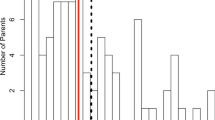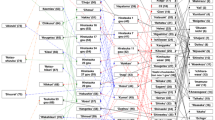Abstract
Silver-stained random amplified polymorphic DNA (ssRAPD) markers have been identified that are always jointly present or absent in the ssRAPD profiles of cranberry varieties. On the basis of segregation data and the ability to re-create these “associated ssRAPDs” through the intermixing of amplified DNA from individuals lacking them, five of the six pairs of associated ssRAPDs analyzed were shown to be consistent with heteroduplex molecules. Heteroduplexes are “hybrid”” double-stranded DNAs that are formed following the polymerase chain reaction (PCR) amplification of two DNA segments that have a high degree of homology to one another, yet differ in their nucleotide sequences as a result of base pair deletions, additions, or substitutions. Three of the five putative heteroduplex systems identified are consistent with a one locus, two-allele heteroduplex model. The remaining two systems appeared to be multi-allelic, involving interactions among three and four alleles, respectively. RAPD heteroduplex formation has the potential to confound genetic relatedness and pedigree studies. Heterozygous individuals exhibit heteroduplex RAPDs not seen in either of the two homozygote classes. Genetic estimates under such a circumstance would “inflate” the differences between the heterozygote and the homozygote classes. Heteroduplex formation is also a mechanism for the presence of non-parental RAPDs in progeny of parents homozygous for alternate alleles. While this class of molecular markers can confound RAPD analyses, they also offer a source of co-dominant RAPD markers, which are of value in genetic relatedness estimates and as markers for studying breeding behavior.
Similar content being viewed by others
References
Ayliffe MA, Lawrence GJ, Ellis JG, Pryor AJ (1994) Heteroduplex molecules formed between allelic sequences cause nonparental RAPD bands. Nucleic Acids Res 22:1632–1636
Davis TM, Yu H, Haigis KM, McGowan PJ (1995) Template mixing: a method of enhancing detection in interpretation of codominant markers. Theor Appl Genet 91:582–588
Hadrys H, Balick M, Schierwater B (1992) Applications of random amplified polymorphic DNA (RAPD) in molecular ecology. Mol Ecol 1:55–63
Hatcher SLS, Lamber QT, Teplitz RL, Carlson JR (1993) Heteroduplex formation: a potential source of genotyping error from PCR products. Prenat Diag 13: 171–177
Howell EC, Newbury HJ, Swennen RL, Withers LA, Ford-Lloyd BV (1994) The use of RAPD for identifying and classifying Musa germ plasm. Genome 37:328–332
Hu J, Quiros CF (1991) Identification of broccoli and cauliflower cultivars with RAPD markers. Plant Cell Rep 10:505–511
Hunt GJ, Page RE (1992) Patterns of inheritance with RAPD molecular markers reveal novel types of polymorphism in the honey bee. Theor Appl Genet 85:15–20
Kresovich S, Lamboy WF, Rugang L, Ren J, Szewc-McFadden AK, Bliek SM (1994) Application of molecular methods and statistical analyses for discrimination of accessions and clones of vetiver grass. Crop Sci 34:805–809
Marsolais JV, Pringle JS, White BN (1993) Assessment of random amplified polymorphic DNAs (RAPDs) as genetic markers for determining the origin of interspecific lilac hybrids. Taxon 42: 531–537
Novy RG, Vorsa N (1995) Identification of intracultivar genetic heterogeneity in cranberry using silver-stained RAPDs. Hort Science 30:600–604
Novy RG, Kobak C, Goffreda J, Vorsa N (1994) RAPDs identify varietal misclassification and regional divergence in cranberry (Vaccinium macrocarpon Ait.). Theor Appl Genet 88:1004–1010
Ronning CM, Schnell RJ, Kuhn DN (1995) Inheritance of random amplified polymorphic DNA (RAPD) markers in Theobroma cacao L. J Am Soc Hort Sci 120:681–686.
Sarracino JM, Vorsa N (1991) Self and cross fertility in cranberry. Euphytica 58:129–136
Shoemaker DD, Ross KG, Arnold ML (1994) Development of RAPD markers in two introduced fire ants, Solenopsis invicta and S. richeteri, and their application to the study of a hybrid zone. Mol Ecol 3:531–539
Stammers M, Harris J, Evans GM, Hayward MD, Forster JW (1995) Use of random PCR (RAPD) technology to analyse phylogenetic relationships in the Lolium/Festuca complex. Heredity 74: 19–27
Stewart CN Jr, Via LE (1993) A rapid CTAB DNA isolation technique useful for RAPD fingerprinting and other PCR applications. BioTechniques 14: 748–750
Stiles JI, Lemme C, Sondur S, Morshidi MB, Manshardt R (1993) Using randomly amplified polymorphic DNA for evaluating genetic relationships among papaya cultivars. Theor Appl Genet 85:697–701
Van Coppenolle B, Watanabe I, Van Hove C, Second G, Huang N (1993) Genetic diversity and phylogeny analysis of Azolla based on DNA amplification by arbitrary primers. Genome 36:686–693
Wang G, Castiglione S, Zhang J, Fu R, Ma J, Li W, Sun Y, Sala F (1994) Hybrid rice (Oryza sativa L.): identification and parentage determination by RAPD fingerprinting. Plant Cell Rep 14:112–115
Weaver KR, Caetano-Anolles G, Gresshoff PM, Callahan LM (1994) Isolation andcloning of DNA amplification products from silverstained polycacrylamide gels. Biotechniques 16:226–227
Weeden NF, Timmerman GM, Hemmat M, Kneen BE, Lodhi MA (1992) Inheritance and reliability of RAPD markers. Proc Appl RAPD Tech Plant Breed, pp 12–17
White MB, Carvalho M, Derse D, O'Brien SJ, Dean M, (1992) Detecting single-base substitutions as heteroduplex polymorphisms. Genomics 12:301–306
Williams CE, St. Clair DA (1993) Phenetic relationships and levels of variability detected by restriction fragment length polymorphism and random amplified polymorphic DNA analysis of cultivated and wild accessions of Lycopersicon esculentum. Genome 36:619–630
Yang X, Quiros CF (1993) Identification and classification of celery cultivars with RAPD markers. Theor App] Genet 86:205–212
Author information
Authors and Affiliations
Additional information
Communicated by G. E. Hart
Supported by State and U.S. Federal funds, CSRS grant 93-34155-8382, and Ocean Spray Cranberries, Inc.
Rights and permissions
About this article
Cite this article
Novy, R.G., Vorsa, N. Evidence for RAPD heteroduplex formation in cranberry: implications for pedigree and genetic-relatedness studies and a source of co-dominant RAPD markers. Theoret. Appl. Genetics 92, 840–849 (1996). https://doi.org/10.1007/BF00221896
Received:
Accepted:
Issue Date:
DOI: https://doi.org/10.1007/BF00221896




